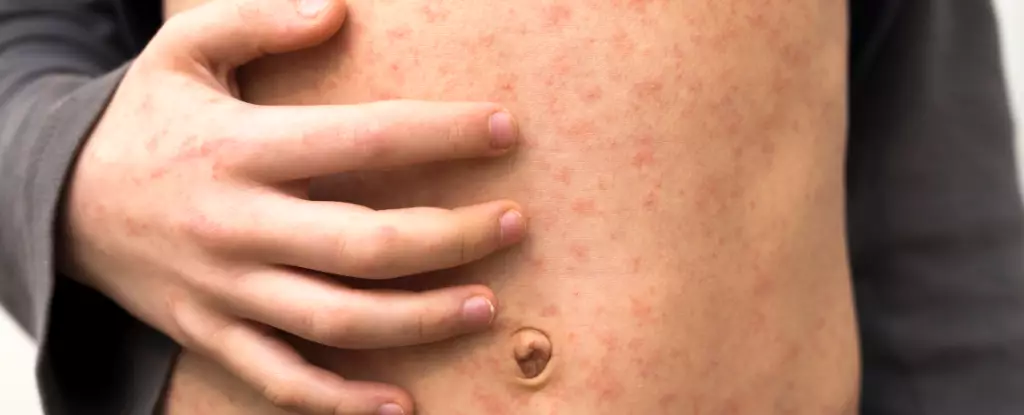The alarming resurgence of the measles outbreak that began in West Texas in late January 2025 is a stark reminder of our vulnerabilities regarding vaccine-preventable diseases. As of March 28, 2025, confirmed cases have reached a staggering 400 in Texas alone, with neighboring states—New Mexico and Oklahoma—reporting over 50 additional cases. Public health experts project that the numbers could be significantly higher than official reports indicate, igniting concerns of a broader, potentially disastrous resurgence of this highly contagious virus across the United States.
The associated risks seem to be compounded by reported potential exposures on public transport and in crowded areas such as Washington Dulles International Airport and on Amtrak trains. The very environments designed for mobility and community engagement become settings for viral transmission—emphasizing how quickly and unpredictably outbreaks can escalate when vaccination rates dip.
The Hidden Dangers of Measles
Many underestimate the severity of measles, often dismissing it as merely a childhood ailment characterized by fever and a rash. Yet, the reality is starkly different: measles infections can result in serious complications, including pneumonia and encephalitis, which can lead to lifelong disabilities or even death. Early statistics from 2025 indicate that 14% of patients required hospitalization—a troubling rate that highlights the serious implications of this viral infection. Hospitals can become inundated with measles cases just as they are tasked with managing other health crises, further straining public health resources.
The nature of the virus itself makes it insidious. Measles is one of the most contagious diseases known to mankind, capable of infecting 9 out of 10 unvaccinated individuals who come into contact with an infected person. This ability to spread so rapidly among susceptible populations underscores the urgent need for widespread vaccination to establish herd immunity and protect those who cannot be vaccinated due to medical conditions.
The Mechanisms of Infection: Understanding How Measles Affects the Body
From a biological standpoint, the mechanisms by which the measles virus attacks the body are both fascinating and terrifying. Upon entering the body, the virus targets respiratory cells, leading to damage that impairs breathing and can facilitate the development of more severe manifestations like viral pneumonia. Typically, this is what requires hospitalization, as coughing and difficulty breathing can escalate into critical situations, particularly for children. It’s critical to note that about 1 in 20 children may develop pneumonia as a complication of measles, making it a leading cause of mortality from the disease.
Moreover, the virus doesn’t stop at the lungs; it also infiltrates immune cells, effectively commandeering the body’s defense systems. The ramifications of this can be long-lasting and debilitating, illustrating a deceptive aftereffect of measles infections—children infected can emerge with a compromised immune system that struggles to fight off other pathogens.
Long-Term Effects: A Grim Reality of Measles
Perhaps the most chilling consequence of measles is its potential for delayed neurological damage. Acute brain injury can occur due to direct infection or subsequent inflammation, with both phenomena well-documented. A staggering 1 in 1,000 individuals can suffer from acute brain damage; those who survive may face permanent disabilities such as blindness or hearing impairments. This reality adds a layer of grim urgency to the vaccination debate—overlooking measles is not merely ignoring a temporary illness; it is disregarding a pathway to long-term impairment.
An even more sinister aspect is the possibility of subacute sclerosing panencephalitis (SSPE), a progressive neurological disorder that can emerge 7 to 10 years post-infection. While rare, it underscores the unrelenting danger posed by the virus, raising the alarming prospect that those who seem to recover entirely can still suffer devastating consequences years later. Instances of SSPE appear more frequently in infants infected before age one, highlighting the vulnerability of the youngest among us.
The Path Forward: Prioritizing Vaccination and Public Health
As the outbreak unfolds, the scientific community is actively researching potential antibody therapies to manage severe cases of measles. However, these avenues should not overshadow the most effective means of prevention: vaccination. The measles vaccine has demonstrated an impressive efficacy rate of 97% with a two-dose regimen, making it a cornerstone of public health initiatives.
Nevertheless, the challenges remain: misinformation surrounding vaccinations continues to proliferate, eroding the societal consensus required to maintain high vaccination coverage. Public awareness campaigns must emphasize not only the individual benefits of the measles vaccine but also its critical role in protecting vulnerable populations within communities. Ensuring that future generations grow up free from the looming threat of measles requires vigilance, education, and unwavering commitment to public health values.


Leave a Reply